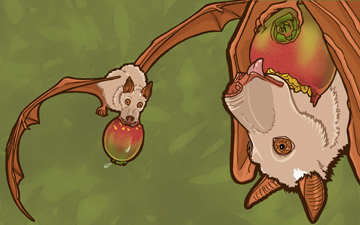The hammer-headed bat (Hypsignathus monstrosus), also known as the big-lipped bat, is widely distributed in equatorial Africa. This large bat is found in riverine forests, mangroves, swamps, and palm forests at elevations less than 1800 meters.
The hammer-headed bat is the largest bat in Africa with a wingspan of 686 to 970 millimeters. Males are significantly larger than females, averaging 400 grams while females average only 275 grams.
Pelage is grey-brown to slaty-brown with a whitish collar of fur extending from shoulder to shoulder. The flight membranes are brown and the ears are dark brown with a tuft of white fur at the base. The face is dark brown with a few long, stiff whiskers around the mouth.
The skull may be diagnosed by specific dental features. The second premolar and molars are markedly lobed. This feature is specific for this genus, and no other African fruit bats have this characteristic.
There is extreme sexual dimorphism in this species. The male possesses an enormous head for producing loud honking calls. The enlarged rostrum, larynx and lips allow these sounds to be extremely resonant. The larynx is one half the length of the vertebral column and fills out most of the thoracic cavity. It is nearly three times larger in males than females. The male also has a hairless split chin and warty rostrum with wrinkled skin around it. Females have a much more fox-like appearance similar to most fruit bats.
(From Wikipedia, May 17th, 2010)
– – –
Hypsignathus monstrosus is the largest bat found in Africa, with males being significantly larger than females. Males range in mass from 228 g to 450 g, averaging 377 g. Females are about half the size, weighing from 218 to 377 g, and averaging 275 g. Males range in length from 220 to 280 mm, with an average of 250 mm. Females measure 195 to 225 mm, averaging 210 mm. Males have a wingspan of 686 to 970 mm, and females have an average wingspan of 840 mm.
The species is sexually dimorphic in facial features as well as in size. Males have an enlarged rostrum and larynx, and a large, square head. They can also be distinguished by their huge, pendulous lips, flaps around a warty snout, a bald, split chin and cheek pouches. To human eyes, these bats are really ugly, prehaps accounting for their species name, “monstrosus.” Females also have a square-shaped head, but their muzzle is fox-shaped and lacks the unique lip, snout, and chin characteristics of the male.
The ears are rounded at the base and the tail is very short. There is a claw on the second finger and this bat has large, flexible thumbs.
The pelage is slate-brown and there is a white collar of fur that stretches from shoulder to shoulder. The face and wing membranes are dark brown and the ears are dark brown with white tufts at the base.
(Langevin and Barclay, 1990; Kulzer, 1990; Macnamara et al., 1979)
(From EOL via Animal Diversity Web)




